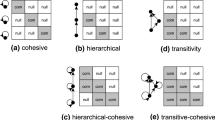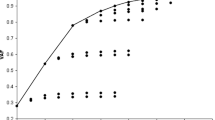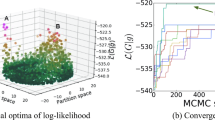Abstract
Two-mode binary data matrices arise in a variety of social network contexts, such as the attendance or non-attendance of individuals at events, the participation or lack of participation of groups in projects, and the votes of judges on cases. A popular method for analyzing such data is two-mode blockmodeling based on structural equivalence, where the goal is to identify partitions for the row and column objects such that the clusters of the row and column objects form blocks that are either complete (all 1s) or null (all 0s) to the greatest extent possible. Multiple restarts of an object relocation heuristic that seeks to minimize the number of inconsistencies (i.e., 1s in null blocks and 0s in complete blocks) with ideal block structure is the predominant approach for tackling this problem. As an alternative, we propose a fast and effective implementation of tabu search. Computational comparisons across a set of 48 large network matrices revealed that the new tabu-search heuristic always provided objective function values that were better than those of the relocation heuristic when the two methods were constrained to the same amount of computation time.
Similar content being viewed by others
References
Aarts, E., & Korst, J. (1989). Simulated annealing and Boltzmann machines: a stochastic approach to combinatorial optimization and neural computing. New York: Wiley.
Airoldi, E.M., Blei, D.M., Fienberg, S.E., & Xing, E.P. (2008). Mixed-membership stochastic blockmodels. Journal of Machine Learning Research, 9, 1981–2014.
Arabie, P., Hubert, L., & Schleutermann, S. (1990). Blockmodels from the bond energy algorithm. Social Networks, 12, 99–126.
Batagelj, V., Ferligoj, A., & Doreian, P. (1992). Direct and indirect methods for structural equivalence. Social Networks, 14, 63–90.
Bickel, P.J., & Chen, A. (2009). A nonparametric view of network models and Newman-Girvan and other modularities. Proceedings of the National Academy of Sciences, 106, 21068–21073.
Borgatti, S.P., & Everett, M.G. (1997). Network analysis of 2-mode data. Social Networks, 19, 243–269.
Borgatti, S.P., Everett, M.G., & Freeman, L. (2002). Ucinet for Windows: software for social network analysis. Harvard: Analytic Technologies.
Breiger, R.L., Boorman, S.A., & Arabie, P. (1975). An algorithm for clustering relational data with applications to social network analysis and comparison to multidimensional scaling. Journal of Mathematical Psychology, 12, 328–383.
Brusco, M., Doreian, P., Mrvar, A., & Steinley, D. (2011). Linking theory, models, and data to understand social network phenomena: two algorithms for relaxed structural balance partitioning. Sociological Methods & Research, 40, 57–87.
Brusco, M.J., & Köhn, H.F. (2009). Clustering qualitative data based on binary equivalence relations: neighborhood search heuristics for the clique partitioning problem. Psychometrika, 74, 685–703.
Brusco, M.J., & Stahl, S. (2001). An interactive approach to multiobjective combinatorial data analysis. Psychometrika, 66, 5–24.
Brusco, M.J., & Stahl, S. (2005). Optimal least-squares unidimensional scaling: improved branch-and-bound procedures and comparison to dynamic programming. Psychometrika, 70, 253–270.
Brusco, M., & Steinley, D. (2006). Inducing a blockmodel structure of two-mode binary data using seriation procedures. Journal of Mathematical Psychology, 50, 468–477.
Brusco, M., & Steinley, D. (2007a). A variable neighborhood search method for generalized blockmodeling of two-mode binary matrices. Journal of Mathematical Psychology, 51, 325–338.
Brusco, M.J., & Steinley, D. (2007b). A comparison of heuristic procedures for minimum within-cluster sums of squares partitioning. Psychometrika, 72, 583–600.
Brusco, M.J., & Steinley, D. (2009). Integer programs for one- and two-mode blockmodeling based on prespecified image matrices for structural and regular equivalence. Journal of Mathematical Psychology, 53, 577–585.
Brusco, M., & Steinley, D. (2010). K-balance partitioning: an exact method with application to generalized structural balance and other psychological contexts. Psychological Methods, 15, 145–157.
Charon, I., & Hudry, O. (2006). Noising methods for a clique partitioning problem. Discrete Applied Mathematics, 154, 754–769.
Clapham, C. (1996). The concise Oxford dictionary of mathematics (2nd ed.). Oxford: Oxford University Press.
Davis, A., Gardner, B., & Gardner, M.R. (1941). Deep south. Chicago: University of Chicago Press.
De Amorim, S.G., Barthélemy, J.-P., & Ribeiro, C.C. (1992). Clustering and clique partitioning: simulated annealing and tabu search approaches. Journal of Classification, 9, 17–41.
Doreian, P., Batagelj, V., & Ferligoj, A. (2004). Generalized blockmodeling of two-mode network data. Social Networks, 26, 29–53.
Doreian, P., Batagelj, V., & Ferligoj, A. (2005). Generalized blockmodeling. Cambridge: Cambridge University Press.
Doreian, P., & Mrvar, A. (1996). A partitioning approach to structural balance. Social Networks, 18, 149–168.
Doreian, P., & Mrvar, A. (2009). Partitioning signed social networks. Social Networks, 31, 1–11.
Fienberg, S.E., Meyer, M.M., & Wasserman, S.S. (1985). Statistical analysis of multiple sociometric relations. Journal of the American Statistical Association, 80, 51–67.
Freeman, L.C. (2003). Finding social groups: a meta-analysis of the Southern Women data. In R. Brieger, C. Carley, & P. Pattison (Eds.), Dynamic social network modeling and analysis: workshop summary and papers (pp. 39–97). Washington: The National Academies Press.
Glover, F., & Laguna, M. (1993). Tabu search. In C. Reeves (Ed.), Modern heuristic techniques for combinatorial problems (pp. 70–141). Oxford: Blackwell.
Goldberg, D.E. (1989). Genetic algorithms in search, optimization, and machine learning. New York: Addison-Wesley.
Goldenberg, A., Zheng, A., Fienberg, S.E., & Airoldi, E.M. (2009). A survey of statistical network models. Foundations and Trends in Machine Learning, 2, 1–117.
Govaert, G., & Nadif, M. (2003). Clustering with block mixture models. Pattern Recognition, 36, 463–473.
Groenen, P.J.F., & Heiser, W.J. (1996). The tunneling method for global optimization in multidimensional scaling. Psychometrika, 61, 529–550.
Hand, D.J. (1981). Discrimination and classification. New York: Wiley.
Handcock, M.S., Raftery, A.E., & Tantrum, J. (2007). Model-based clustering for social networks (with discussion). Journal of the Royal Statistical Society A, 170, 301–354.
Hartigan, J. (1972). Direct clustering of a data matrix. Journal of the American Statistical Association, 67, 123–129.
Heller, J. (1961). Catch-22: a novel. New York: Simon and Schuster.
Holland, P.W., & Leinhardt, S. (1976). Local structure in social networks. Sociological Methodology, 7, 1–45.
Holland, P.W., & Leinhardt, S. (1977). A dynamic model for social networks. Journal of Mathematical Sociology, 5, 5–20.
Holland, P.W., & Leinhardt, S. (1981). An exponential family of probability distributions for directed graphs (with discussion). Journal of the American Statistical Association, 76, 33–65.
Holland, P.W., Laskey, K.B., & Leinhardt, S. (1983). Stochastic blockmodels: first steps. Social Networks, 5, 109–137.
Homans, G.C. (1950). The human group. New York: Harcourt-Brace.
Kaiser, S., & Leisch, F. (2008). A toolbox for bicluster analysis in R (Technical Report 028). Munich: Department of Statistics, University of Munich.
Koyutürk, M., Szpanowski, W., & Grama, A. (2004). Biclustering gene-feature matrices for statistically significant patterns. In Proceedings of the 2004 IEEE computational systems bioinformatics conference (pp. 480–484). Washington: IEEE Comput. Soc.
Krolak-Schwerdt, S. (2003). Two-mode clustering methods: compare and contrast. In M. Schader, W. Gaul, & M. Vichi (Eds.), Between data science and applied data analysis (pp. 270–278). Berlin: Springer.
Lauritzen, S.L. (2008). Exchangeable Rasch matrices. Rendiconti di Matematica, 28, 83–95.
Lorrain, F., & White, H.C. (1971). Structural equivalence of individuals in social networks. Journal of Mathematical Sociology, 1, 49–80.
Madeira, S.C., & Oliveira, A.L. (2004). Biclustering algorithms for biological data analysis: a survey. IEEE/ACM Transactions on Computational Biology and Informatics, 1, 24–45.
McLachlan, G.J. (2011). Commentary on Steinley and Brusco (2011): recommendations and cautions. Psychological Methods, 16, 80–81.
Mische, A., & Pattison, P. (2000). Composing a civic arena: publics, projects, and social settings. Poetics, 27, 163–194.
Mladenović, N., & Hansen, P. (1997). Variable neighborhood search. Computers & Operations Research, 24, 1097–1100.
Mrvar, A., & Doreian, P. (2009). Partitioning signed two-mode networks. Journal of Mathematical Sociology, 33, 196–221.
Mulvey, J.M., & Crowder, H.P. (1979). Cluster analysis: an application of Lagrangian relaxation. Management Science, 25, 329–340.
Newman, M.E.J., & Girvan, M. (2004). Finding and evaluating community structure in networks. Physical Review E, 69, 026113. doi:10.1103/PhysRevE.69.026113.
Nowicki, K., & Snijders, T.A.B. (2001). Estimation and prediction for stochastic blockstructures. Journal of the American Statistical Association, 96, 1077–1087.
Pacheco, J., & Valencia, O. (2003). Design of hybrids for the minimum sum-of-squares clustering problem. Computational Statistics and Data Analysis, 43, 235–248.
Pattison, P.E., & Breiger, R.L. (2002). Lattices and dimensional representations: matrix decompositions and ordering structures. Social Networks, 24, 423–444.
Prelić, A., Blueler, S., Zimmerman, P., Wille, A., Bühlmann, P., Gruissem, W., Hennig, L., Thiele, L., & Zitzler, E. (2006). A systematic comparison and evaluation of biclustering methods for gene expression data. Bioinformatics, 22, 1122–1129.
Rolland, E., Schilling, D.A., & Current, J.R. (1996). An efficient tabu search procedure for the p-median problem. European Journal of Operational Research, 96, 329–342.
Steinhaus, H. (1956). Sur la division des corps matétiels en parties. Bulletin de l’Académie Polonaise des Sciences, Classe III, IV(12), 801–804.
Steinley, D., & Brusco, M.J. (2011a). An evaluation of mixture model clustering: recommendations and cautions. Psychological Methods, 16, 63–79.
Steinley, D., & Brusco, M.J. (2011b). K-means clustering and mixture model clustering: reply to McLachlan and Vermunt. Psychological Methods, 16, 89–92.
van Rosmalen, J., Groenen, P.J.F., Trejos, P., & Castillo, W. (2009). Optimization strategies for two-mode partitioning. Journal of Classification, 26, 155–181.
van Uitert, M., Meuleman, W., & Wessels, L. (2008). Biclustering sparse binary genomic data. Journal of Computational Biology, 15, 1329–1345.
Vermunt, J. (2011). K-means may perform as well as mixture model clustering but may also be much worse: comment on Steinley and Brusco (2011). Psychological Methods, 16, 82–88.
von Luxburg, U. (2007). A tutorial on spectral clustering. Statistical Computing, 17, 395–416.
Ward, J.H. (1963). Hierarchical grouping to optimize an objective function. Journal of the American Statistical Association, 58, 236–244.
Wasserman, S., & Faust, K. (1994). Social network analysis: methods and applications. Cambridge: Cambridge University Press.
White, D.R., & Reitz, K.P. (1983). Graph and semigroup homomorphisms on networks of relations. Social Networks, 5, 193–234.
Xu, W., Liu, X., & Gong, Y. (2003). Document clustering based on non-negative matrix factorization. In SIGIR‘03: proceedings of the 26th annual international ACM SIGIR conference on research and development in information retrieval (pp. 267–273). New York: Association for Computing Machinery.
Žiberna, A. (2007). Generalized blockmodeling of valued networks. Social Networks, 29, 105–126.
Author information
Authors and Affiliations
Corresponding author
Rights and permissions
About this article
Cite this article
Brusco, M., Steinley, D. A Tabu-Search Heuristic for Deterministic Two-Mode Blockmodeling of Binary Network Matrices. Psychometrika 76, 612–633 (2011). https://doi.org/10.1007/s11336-011-9221-9
Received:
Revised:
Published:
Issue Date:
DOI: https://doi.org/10.1007/s11336-011-9221-9




